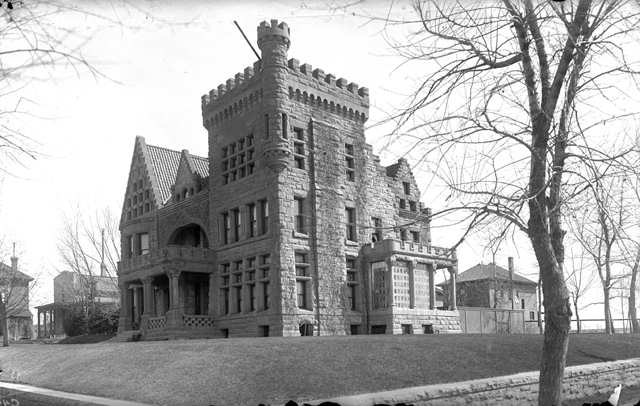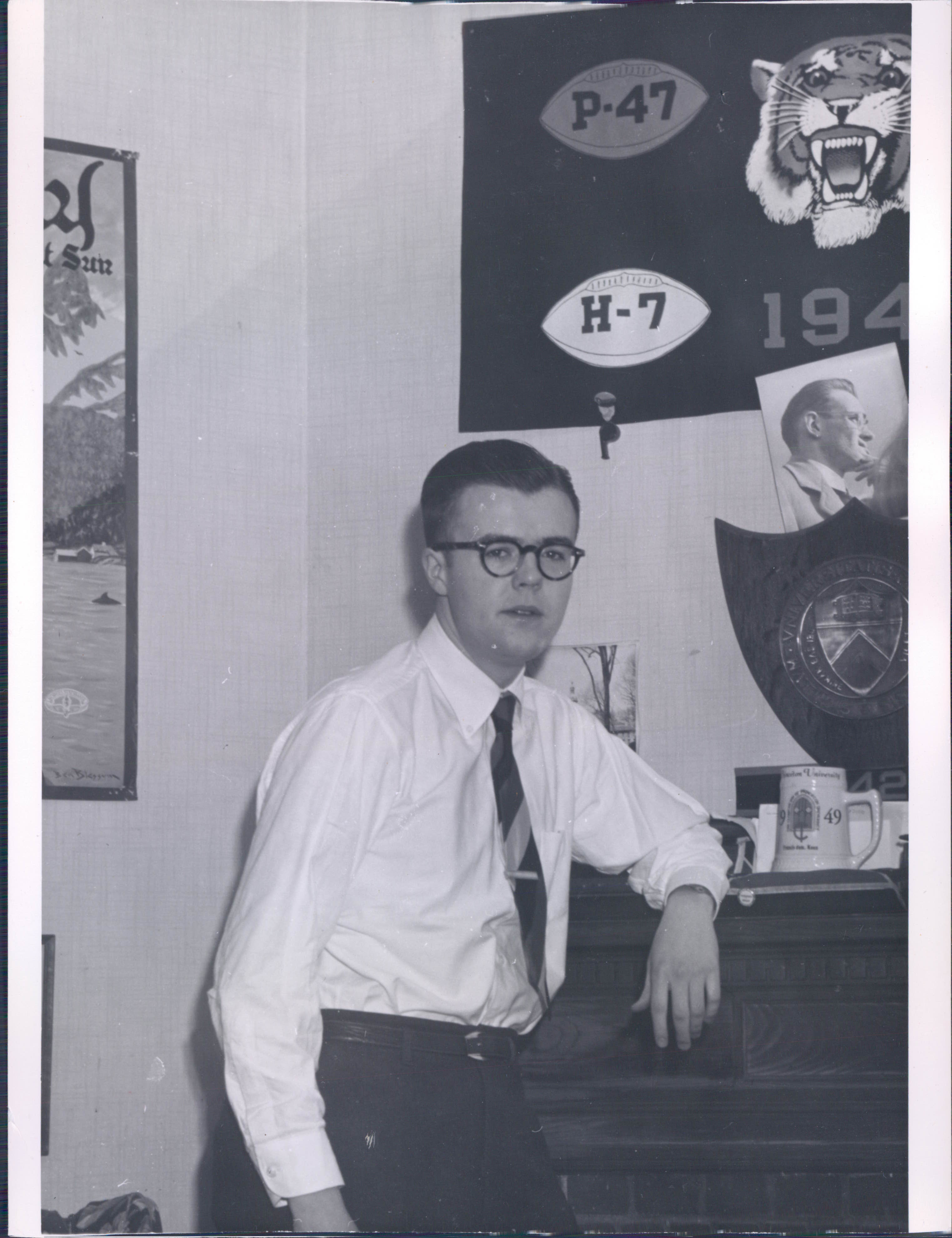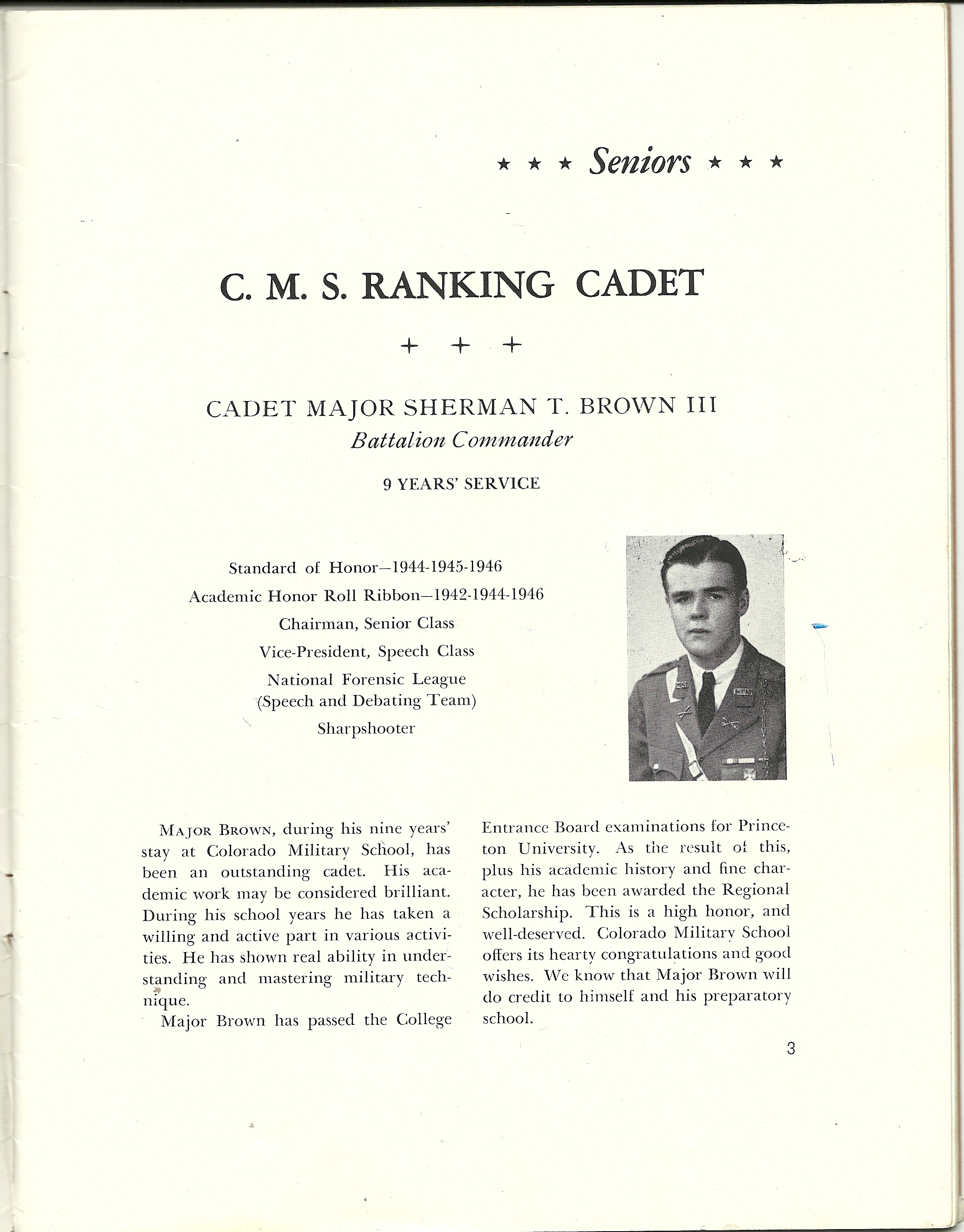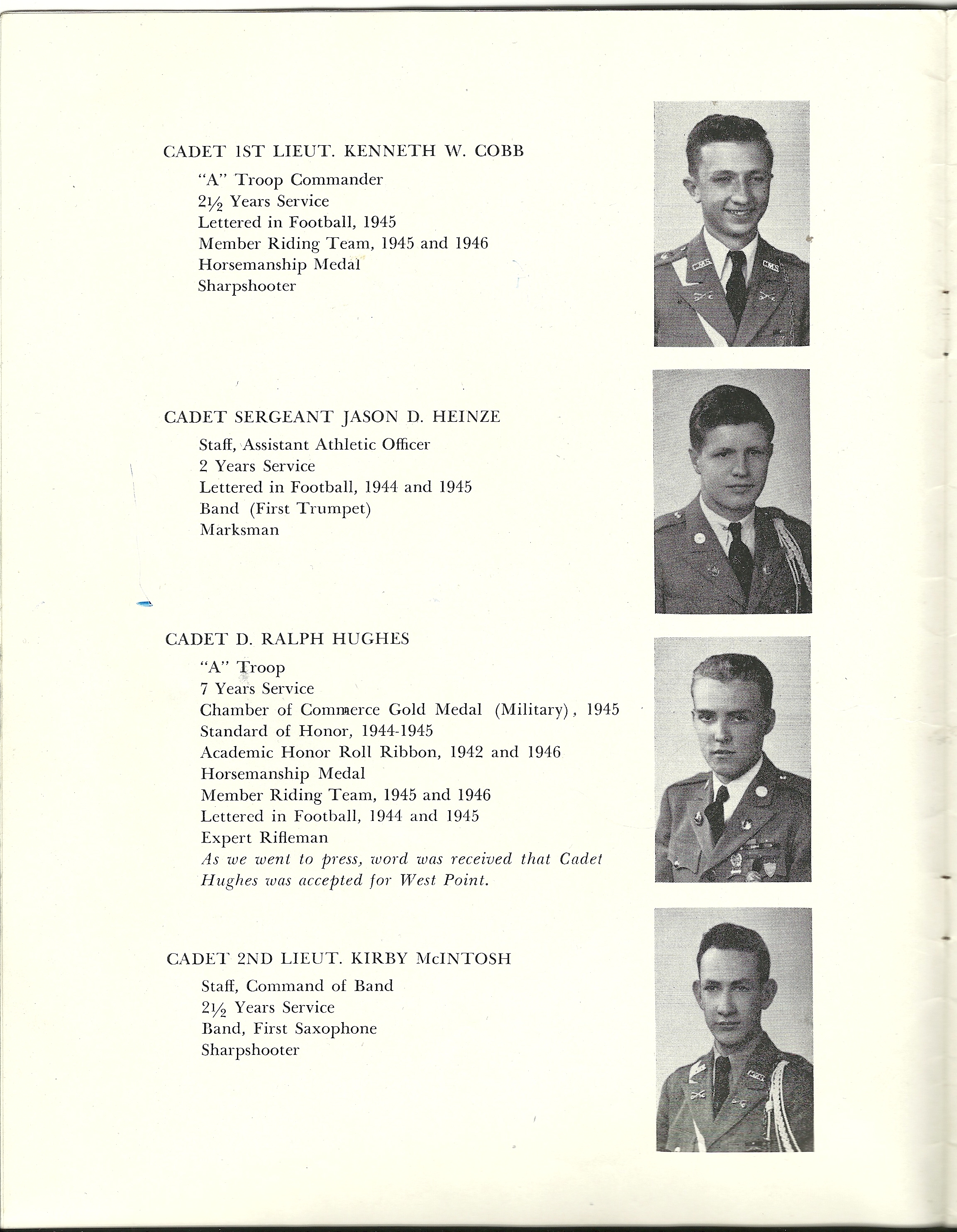MY DENVER HOMES AND SCHOOLING
My mother, Helen Hughes managed to get a start after Ralph’s death in Denver making a living by operating a series of small boarding houses. Single rooms and board. Her guests were often single working women, some, divorced with one child, who worked downtown or along South Broadway, because the Denver Street Car system was well developed, fares were cheap, and work was plentiful if low paying in the late 30s.
It was then possible for her to give me a place to live as I started Middle School. My older half-sisters were eager to get out of the house and be on their own, while sister Bette, 6 years younger than I was still at home.
The next ten years of my life were a kaleidoscope of different homes, schools, and summer work experiences. Intermixed with stays at Aunt Arleen’s Colorado Springs House, and the Hughes Ranch. I got to know Denver quite well, especially South Denver.
I can still name the addresses where I lived, starting with 5 Grant Street, a small bungalow which had the advantage of being not only one block to Broadway and its street cars, but also Trailways Bus would pick me on Broadway and drive me to Colorado Springs where someone would meet me and get me to Arleen’s home. I did those trips many times.
A half block further north on Grant my mother opened a large home as a Boarding House. Probably with 4 guests at most, me with my own room, sister Jeanne with hers, and Bette in with Mother.
But then we moved to 840 Ogden Street, larger with three floors holding perhaps 6 paying guests. I went to Dora Moore School which was just two walking blocks away.
One day my sister Jeanne saved my life when I, playing cowboys against bandits with other kids, put a rope around my neck and stood on the porch railing, playing a bandit being hanged. The image was often played in the neighborhood movie theaters in the heyday of Westerns. I jumped off the railing and started to strangle when, for some reason, older sister Jeanne came out on the porch, saw me and lifted me up to freed me from the rope.
Life was still difficult for my mother. So much so that my sister Bette, when she was 8 needed a more normal life, so Aunt Arleen as she had done with me, let Bette live with her in Colorado Springs, while she went to Steele Elementary School for one year, before she moved back to Denver.
Budding Interest in History
It was living in that area of Denver I became aware of the ‘faded mansions’ part of town, which once, in the 1890s were built by successful businessmen, mining – gold and silver – ventures, and a very healthy brick industry, from which many of the homes were built. My latent interest in history began to be prodded. I was already writing short pieces about many things, in pencil. The 'Unsinkable Molly Brown's' house is in that neighborhood.
The second thing that further whetted my appetite for historic buildings was when my mother was able to lease a beautiful large 3 floor castle at 1000 Corona Street in Denver. She would turn it into a boarding house. It had been called the ‘Church Castle’ because a man named William Church, copper magnate, built it in 1894.
It was ghostly in places with secret passageways behind the walls – all of which I explored of course. And a crenellated roof with ramparts from which I threw down snowballs at kids challenging me. It looked like a Medieval fortress. It was beautiful, inside and out and made its own basic case for ‘Historic Preservation’ It was such a splendid example of 1890s architecture photographs of it ended in the elegant book “Denver On Glass’ – glass negatives of Denver scenes and mansions for the ‘First 50 Years of Denver’ and a treatise on ‘Denver Historic Mansions, with black and white photos and long descriptions of the owners and why they chose to build such buildings was published.
Sometime after I left for West Point, developers razed the magnificent building and replaced it with a dull appearing apartment complex. The outcry in Denver was so great, as the country began to value 'historic houses,' that the destruction of the Church Castle spawned the organization called ‘Historic Denver’ which set about saving historic building such as the Molly Brown House – the home of the Unsinkable (Titanic) Molly Brown.
While I lived in the Church Castle as a boy it was the most elegant Boarding House in all Colorado. It made a deep impression on me.
 |
|
The 'Church Castle' in old Denver - at 1000 Corona Street |
But my mother wanted more for me. Above all she wanted her only son to amount to something by getting a good education, and get me the influence by male men substituting for my dead father.
First Taste of Things Military
First of all she enrolled me in a long standing Denver organization formed by WWI veterans called the Highlander Boys. A kind of military boy scouts. My first mountain camping experience was with them near Estes Park. And I got to march up Broadway with a wooden rifle in front of the state Capital building when a Presidential candidate came to speak. I think it was Roosevelt.
But then she learned about the Colorado Military School, a military school which took boys from grade school through high school, was both a boarding and day school, had horses for military riding, jumping, equestrian skills, and offered a ‘prep high-school’ curriculum. Its education was comparable to other small co-educational prep-schools in Denver, such as Randall, and Kent Country Day. Most of the parents of students attending these were well heeled.
She could not afford to pay for my entry by herself. So she went to see wealthy Aunt Arleen, who was skeptical, but who finally augmented what my mother could pay, especially for the day school where I would be bused to and from the school daily with perhaps 20 other ‘day students.’
So I entered CMS in the 6th Grade in 1940, and stuck with it through high school graduation in 1946. It was that experience that first introduced me to ‘military life’ with plenty of adult men around. There I learned about West Point. Since World War II started one year after I entered the school, and significantly, CMS prep-school education could prepare me for the far more demanding educational demands of the United States Military Academy. Possibilities for my future were beginning to take shape in my young mind.
CMS was a fairly small – just over 160 cadets – military school, some of whose students were ‘bad boys’ whose parents sent them to straighten them out. Other students were from relatively well-off Denver families who wanted a prep education but in the fashion of the day, some ‘military’ experience. Some were from out of state. In fact I learned how to dance The Charleston from fellow cadet Barclay Childers from Mobile, Alabama.
 |
| Cadet David Hughes |
I am pictured at Colorado Military School wearing my prized 1945-46 Horsemanship Medal and 1945 Denver Chamber of Commerce Military Medal plus the Expert Marksmanship Medal I first won on December 7th, 1941.
 |
|
On my favorite Cavalry school horse |
 |
| One of my honors as I mastered the acadmic courses |
The school was fashioned around the ‘mounted and cavalry’ experience, and associated military skills.
I thrived in that atmosphere. It provided me much of what a father would have given me had he lived. Most of the faculty was not eligible for WWII military service. A consumptive Harvard graduate, ‘Captain Mars’ taught me mathematics. A one legged Captain Roberts not only taught me Chemistry, but also was a confidante for a boy growing up in his teen years Too old for service Captain Slaby taught me military discipline. Colonel Hardy, the School Head, taught me horsemanship beyond what I learned on the ranch. The civilian football coach recognized my pretty good athletic abilities and made me quarterback my senior year. But above all the Principal of the School, Ramona Curtis, who was a graduate of Eastern Woman’s College, sensed my budding literary skills and tutored me in Literature and the power of Poetry and literary art.
For 4 of my 6 CMS years I was a day student. But I lived at the school the last 2 years.
I had already spent three of the six summer vacation times doing different things and going different places.
In 1942 I went hunting in a remote area of New Mexico out of a cabin owned by a classmate’s father.
In 1943 I got to camp and stay a week in a wilderness cabin in Yellowstone National Park, getting to know its extraordinarily different thermal activities. The rest of the summer I was able to go to Omaha, Nebraska where Aunt Mary and Uncle John Kretchmer lived and owned a photography store. There I learned, from down in the commercial darkroom, to handling cameras, and from both my uncle and aunt how to take and develop pictures, a photographic set of skills that served me the rest of my life. But those skills were also of value when I attended West Point.
In 1944 I went to New Mexico, lived with my sister Dorothy and her husband Karl in Tucumcari and worked for the US Reclamation Service on irrigation survey crews that went far out into the field, crossing many a ‘dry wash’ that became flash flooded, stranding us at times. We mapped out laterals and sub laterals for irrigation canals off the Canadian River. Hot work and I came home toasted brown.
Somewhere down there in southern New Mexico is a Sub Lateral that was named ‘Hughes’ after they ran out of names. Don’t know if it ever carried water.
Two experiences as a day student were noteworthy.
When we lived at 840 Ogden St, if I wanted to visit the school on weekends, which was in far southeast Denver near Denver University, I had to ride the streetcar to get close enough to walk.
One Sunday morning, I was scheduled to get to the school, and on the small bore rifle range, get qualified as a marksman under NRA rules. I took the street car all the way to east Evans Street and walked the 2 blocks on Columbine Street to the School, and down into the basement rifle range.
For about 3 hours I fired .22 Caliber rifles through all the paces, and by the end had my Expert Badge. So I was a good shot. But the session confirmed in me what I long suspected. While I was nominally right handed, I have always been a better shot – left handed. That fact would be both a curse and a blessing when I went to war years later, as many Army weapons are designed for just right handed shooters.
But while I was down on mats that December 7th day shooting along with 6 or 8 other cadets, a radio was playing in the background. I became aware by the talk of the adults present there was ‘news’ on. I just didn’t know what it was about. I was busy learning how to shoot a deadly weapon. When my training and testing time was over, about 3PM, I started for home. To save the fare I chose to walk the 5 miles home.
By the time I got home about supper time, World War II had started. It was December 7th, 1941. I was 13 years old.
We later lived at 590 Lafayette Street – another boarding house - noted for being a block away from the girlhood home of Mame Eisenhower.
While as a CMS student during the war I wondered from time to time whether the Japanese were going to try and invade America, and I would be somehow fighting, the main thing that happened in me was that I suddenly took a keen interest in real and not comic book wars.
Tom Brown
The second thing noteworth was my developing my best friendship at Colorado Military School with a classmate improbably named Tom Brown. His father was a successful Princeton graduate, and in banking. He pointed Tom toward the same goal. We got along I suppose because we were academically the top two students for four years at the school. He was smarter than I was, but we competed vigorously. The teachers all saw that he was naturally bright and did not have to work hard to get all A’s. I only excelled through hard study work. Ramona Curtis the Principal really admired Tom’s talent, but seemed to see in me someone who got where I was going, and had a flair for writing.
Unlike Tom, who was overweight and not athletic, I was growing into a fast endurance runner and all around athlete for my high school weight that was around 145lbs. It was routine for me to run a mile up Buchtel Boulevard and back just for the heck of it. My height of athletic attainment came when I quarterbacked our high school football team, and beat larger and greatly more endowed Fountain Valley School a perennial adversary in 1945. I was also on the CMS team that was defeated 102 to 0 by a large Denver high school powerhouse, which got some national publicity. Win some and Lose some.
 |
| Tom Brown. Classmate |
Tom Brown, my best high school friend who was far smarter than I, went to Princeton, was kicked out for drinking too much, was drafted into the Korean War - carried a BAR there - became a bank clerk, had a boy, but died in the 1960s. But his son graduated from CMS too..
Tom and I became fast buddies. One day he gave me a fat, 600 page book ‘War’ that his well educated father had given him as a Christmas gift. It was a compendium of scores of writings about warfare. In it I learned how the Japanese defeated the Russians in a Naval Battle in 1904. Historical Greek Battles. The Civil War. Napoleonic Wars. Excerpts about World War I.
I was hooked. THIS was my real military education. Strategy, tactics, leadership. Not just the drills of Colorado Military School or the parades of the Highlander Boys or the Pathe Movie News about the current war.
I began also, at the military school to attain higher and higher cadet rank.
Paralleling that, I was becoming part of risk- taking tick riding on our Cavalry horses. Not only did we do Hunts over obstacles out on the eastern limits of Denver, but advanced trick riding where I could stand on the back of my horse without special hooks for my feet (such as professional trick riders use) – just a horse blanket cinched down – and went over gates as high as 6 feet. A few large tumbles but no broken bones. And a crowd pleaser at all the shows CMS attended. I became an expert horseman while a few other classmates were as good.
Every year the CMS Horse Show team competed in the National Western Stock Show and Rodeo in January. On one occasion after I had attained high cadet rank, I got into competitive fun with the cowboys who bronc and bull rode, with me in my cadet uniform. We exchanged whisky drinks, and the school head Col Harding in the audience saw me coming out of the chute on a bucking bronco, tipsy, without my cadet coat or tie on, until I was bucked off.
Needless to say I was busted to cadet private from being the cadet ‘Major.’ Not the first time that I overreached in order to show my prowess, and was punished for it. I began to suspect I was a kind of maverick, even in a military organization. That I marched to my own inner drum a lot.
But I had already earned the Horsemanship Medal of the 45-46 year, and the Denver Chamber of Commerce Military award for 1945, and I stood second academically in my class for my accomplishments. But I was eager and ready to graduate by May 1946.
The Graduating Class of 1946
 |
 |
 |
 |
| 1946 Graduation Issue | Top Cadet | 4 of 8 graduating incl me | other 4 graduating |
(After I returned from graduating from West Point and fighting in the Korean War, I donated my West Point 'Tar Bucket' hat to Colorado Military School and Principal Ramona Curtis whom I always credited for getting me academically prepared for West Point. Here is a 1953 photo from the Denver Post about that event)
 |
In the summer of 1945 I went to Salt Lake City, and became an ‘Ice Puller’ for the Utah Ice and Storage Company which produced ice for refrigerator cars on the railroad. Hard physical work, with heavy mechanical systems pulling large blocks of ice, getting it into the box cars as fast as possible after a car was ready. Real manual work. Good for me.
It was also there that I had my first encounter with a homosexual male who spotted me at a municipal swimming pool and attempted to seduce me that evening. It was a disgusting experience. And angered me that a man would try to take advantage of someone younger than he was. It was also clear I had no homosexual inclinations at all.
It was also there while I had just come out of a movie house in downtown Salt Lake City when the news broke about the first Atomic Bomb being dropped on the Japanese. Within weeks the war with Japan was over. I was just 17, and could have enlisted by then – but the war was essentially over.
Decision for West Point
So there was one more detail to attend to, which I had started in the spring of 1945 school year.
I had decided to try for West Point. I contacted my Aunt Arleen Hughes who knew a number of Republican Congressmen. She got Senator Eugene Milliken’s office to send me the requisite application forms. I then had my academic records sent to Admissions, CMS cadet military records witha letters of endorsement about my character and activities. And then I was scheduled for a medical examination at Fitzsimmons Army Hospital in Denver in April, 1946 which I passed. The only notation on that exam was that I had a 'deviated nasal septum.' A slightly bent nose inside. That was not disqualifying. What COULD have precluded my being admitted was the question of 'hay fever." Did I have it? Well, just a little, but I didn't press it, and I went on.
In fact I seem to have had it all my life, and especially in April in some places, including Colorado. It never affected my military service. Just an annoyance.
Senator Milliken, as all Congressmen were, entitled to nominate 2 successful Candidates for the United States Military Academy from their districts. He chose to accept all boys who wanted to go, then after their screening by West Point Admissions personnel for medical and other fitness, matters, subject them to a Competitive Validating examination. The top two scorers would be admitted.
I took the examination with about 15 other applicants, 4 of whom were also fellow Colorado Military Academy students.
I landed the top designation, and got a letter sometime in April welcoming me to the United States Military Academy at West Point, and to report on July 1st, 1946.
High School Graduation
I graduated from Colorado Military School the end of May, 1946. I was the first graduate ever to go to either West Point or Annapolis. Just as the last Souvenir Graduation Publication went to press, it announced that I had been accepted at West Point. That was a big win for Principal Ramona Curtis, and the head of the School as an aid to recruitment of students. If CMS could produce West Pointers anything was possible. Tom Brown was accepted to Princeton.
Colorado Military School, which was founded in 1906 and became a ‘military boys school’ in 1918 evolved over the years into the more general co-educational Colorado Academy, which is very prestigious with a large campus and is quite successful today.
The last two months – June and July 1946 – before traveling to New York and reporting in, I spent on a Guest Ranch high in the Colorado Rockies on the Tarryall River. Courtesy of my Aunt Arleen who paid for it. I was able to get even more in shape hiking and running and riding my last horses (as I learned that that year West Point was discontinuing its Equestrian Training for cadets) saying, goodbye to the girls and civilization as I had known it. I had one girl whom I thought I was falling in love with but it was a tepid and ultimately sorry affair arranged by her socialite mother who thought I was going to inherit my Aunt's wealth.
I took the train to New York City, and then a bus to West Point. And joined 922 other young men between 18 and 23 years old determined to make it through the hardest, physically, mentally, academically 4 year institution in the US that already had proven itself turning out Army officers like Robert E Lee, Ulysses Grant, John Jay Pershing and in the recently concluded war, Dwight Eisenhower and Douglas McArthur, Curtis Lemay. The whole panoply of West Point Graduates who led 8 million Americans to victory in the great war.
I, of course, wondered whether I would measure up.
